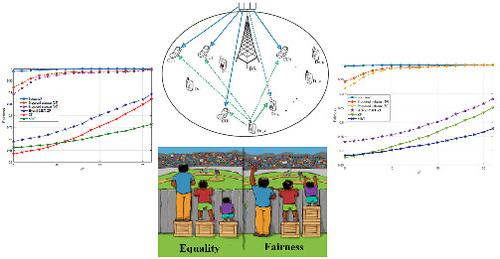当前位置:
X-MOL 学术
›
Int. J. Commun. Syst.
›
论文详情
Our official English website, www.x-mol.net, welcomes your feedback! (Note: you will need to create a separate account there.)
Max–min fair robust beamforming design for underlay device-to-device communications in cellular networks
International Journal of Communication Systems ( IF 2.1 ) Pub Date : 2021-04-25 , DOI: 10.1002/dac.4821 Maryam Alibeigi 1 , Abbas Taherpour 1 , Mehdi Rahmani 1
International Journal of Communication Systems ( IF 2.1 ) Pub Date : 2021-04-25 , DOI: 10.1002/dac.4821 Maryam Alibeigi 1 , Abbas Taherpour 1 , Mehdi Rahmani 1
Affiliation

|
This paper investigates the robust downlink beamforming designs based on max–min fairness and base station (BS) power consumption constraint for device-to-device (D2D) communications underlaying cellular network, under the assumption of imperfect channel state information (CSI) at the BS. Our objective is to maximize the minimum signal-to-interference-plus-noise ratio (SINR) or non-outage probability of users while guaranteeing that the consumed power at the BS is less than a threshold. In particular, three max–min fairness scenarios are considered. In the first scenario, the worst-case SINR of cellular users (CUs) is maximized where the D2D SINR is guaranteed to be above a specified predetermined threshold. In the second scenario, we extend the first scenario and maximized D2D SINR while maximizing CUs' SINR. In these two scenarios, it is assumed that the errors are upper bounded in their Frobenius norms. In the third scenario, the minimum non-outage probability of users is maximized, while a probabilistic model is considered for the uncertainty of channel covariance matrices. Although such optimization problems are not convex, the semidefinite relaxation (SDR) approach is used to obtain the optimal beamforming matrix, which always complies the rank-one constraint. Simulation results show that significant improvement in terms of minimum SINR of CUs, the minimum non-outage probability of CUs, and the probability of feasibility and the fairness index can be achieved with our proposed algorithms in comparison with other beamforming schemes.
中文翻译:

蜂窝网络中底层设备到设备通信的最大-最小公平稳健波束成形设计
本文研究了基于最大-最小公平性和基站 (BS) 功耗约束的稳健下行链路波束成形设计,用于基于蜂窝网络的设备到设备 (D2D) 通信,假设信道状态信息 (CSI) 不完美学士。我们的目标是最大化用户的最小信干噪比 (SINR) 或非中断概率,同时保证 BS 消耗的功率小于阈值。特别地,考虑了三个最大-最小公平性场景。在第一种情况下,蜂窝用户 (CU) 的最坏情况 SINR 被最大化,其中 D2D SINR 保证高于指定的预定阈值。在第二个场景中,我们扩展了第一个场景并最大化了 D2D SINR,同时最大化了 CU 的 SINR。在这两种情况下,假设误差在其 Frobenius 范数中是有上限的。在第三种情况下,最大化用户的最小非中断概率,同时针对信道协方差矩阵的不确定性考虑概率模型。尽管此类优化问题不是凸的,但使用半定松弛 (SDR) 方法来获得最佳波束成形矩阵,该矩阵始终符合秩一约束。仿真结果表明,与其他波束赋形方案相比,我们提出的算法在CU的最小SINR、CU的最小非中断概率、可行性概率和公平性指标方面都有显着提高。最大化用户的最小非中断概率,同时针对信道协方差矩阵的不确定性考虑概率模型。尽管此类优化问题不是凸的,但使用半定松弛 (SDR) 方法来获得最佳波束成形矩阵,该矩阵始终符合秩一约束。仿真结果表明,与其他波束赋形方案相比,我们提出的算法在CU的最小SINR、CU的最小非中断概率、可行性概率和公平性指标方面都有显着提高。最大化用户的最小非中断概率,同时针对信道协方差矩阵的不确定性考虑概率模型。尽管此类优化问题不是凸的,但使用半定松弛 (SDR) 方法来获得最佳波束成形矩阵,该矩阵始终符合秩一约束。仿真结果表明,与其他波束赋形方案相比,我们提出的算法在CU的最小SINR、CU的最小非中断概率、可行性概率和公平性指标方面都有显着提高。半定松弛 (SDR) 方法用于获得最佳波束成形矩阵,该矩阵始终符合秩一约束。仿真结果表明,与其他波束赋形方案相比,我们提出的算法在CU的最小SINR、CU的最小非中断概率、可行性概率和公平性指标方面都有显着提高。半定松弛 (SDR) 方法用于获得最佳波束成形矩阵,该矩阵始终符合秩一约束。仿真结果表明,与其他波束赋形方案相比,我们提出的算法在CU的最小SINR、CU的最小非中断概率、可行性概率和公平性指标方面都有显着提高。
更新日期:2021-06-03
中文翻译:

蜂窝网络中底层设备到设备通信的最大-最小公平稳健波束成形设计
本文研究了基于最大-最小公平性和基站 (BS) 功耗约束的稳健下行链路波束成形设计,用于基于蜂窝网络的设备到设备 (D2D) 通信,假设信道状态信息 (CSI) 不完美学士。我们的目标是最大化用户的最小信干噪比 (SINR) 或非中断概率,同时保证 BS 消耗的功率小于阈值。特别地,考虑了三个最大-最小公平性场景。在第一种情况下,蜂窝用户 (CU) 的最坏情况 SINR 被最大化,其中 D2D SINR 保证高于指定的预定阈值。在第二个场景中,我们扩展了第一个场景并最大化了 D2D SINR,同时最大化了 CU 的 SINR。在这两种情况下,假设误差在其 Frobenius 范数中是有上限的。在第三种情况下,最大化用户的最小非中断概率,同时针对信道协方差矩阵的不确定性考虑概率模型。尽管此类优化问题不是凸的,但使用半定松弛 (SDR) 方法来获得最佳波束成形矩阵,该矩阵始终符合秩一约束。仿真结果表明,与其他波束赋形方案相比,我们提出的算法在CU的最小SINR、CU的最小非中断概率、可行性概率和公平性指标方面都有显着提高。最大化用户的最小非中断概率,同时针对信道协方差矩阵的不确定性考虑概率模型。尽管此类优化问题不是凸的,但使用半定松弛 (SDR) 方法来获得最佳波束成形矩阵,该矩阵始终符合秩一约束。仿真结果表明,与其他波束赋形方案相比,我们提出的算法在CU的最小SINR、CU的最小非中断概率、可行性概率和公平性指标方面都有显着提高。最大化用户的最小非中断概率,同时针对信道协方差矩阵的不确定性考虑概率模型。尽管此类优化问题不是凸的,但使用半定松弛 (SDR) 方法来获得最佳波束成形矩阵,该矩阵始终符合秩一约束。仿真结果表明,与其他波束赋形方案相比,我们提出的算法在CU的最小SINR、CU的最小非中断概率、可行性概率和公平性指标方面都有显着提高。半定松弛 (SDR) 方法用于获得最佳波束成形矩阵,该矩阵始终符合秩一约束。仿真结果表明,与其他波束赋形方案相比,我们提出的算法在CU的最小SINR、CU的最小非中断概率、可行性概率和公平性指标方面都有显着提高。半定松弛 (SDR) 方法用于获得最佳波束成形矩阵,该矩阵始终符合秩一约束。仿真结果表明,与其他波束赋形方案相比,我们提出的算法在CU的最小SINR、CU的最小非中断概率、可行性概率和公平性指标方面都有显着提高。



























 京公网安备 11010802027423号
京公网安备 11010802027423号